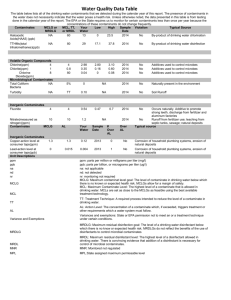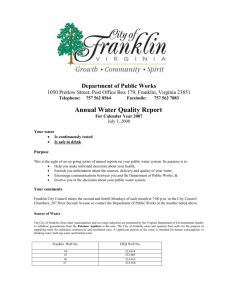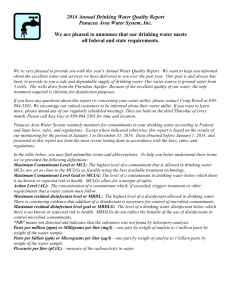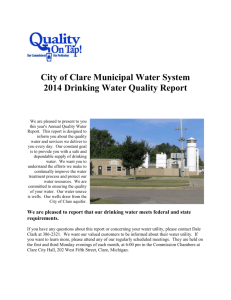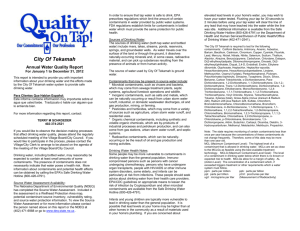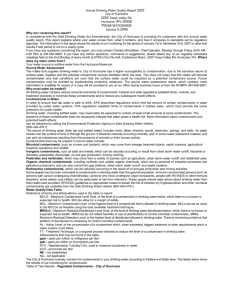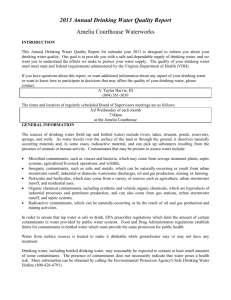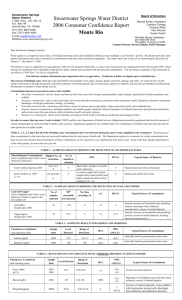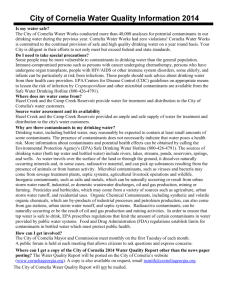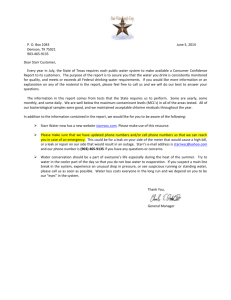CCR - Western Allegheny County Municipal Authority.
advertisement
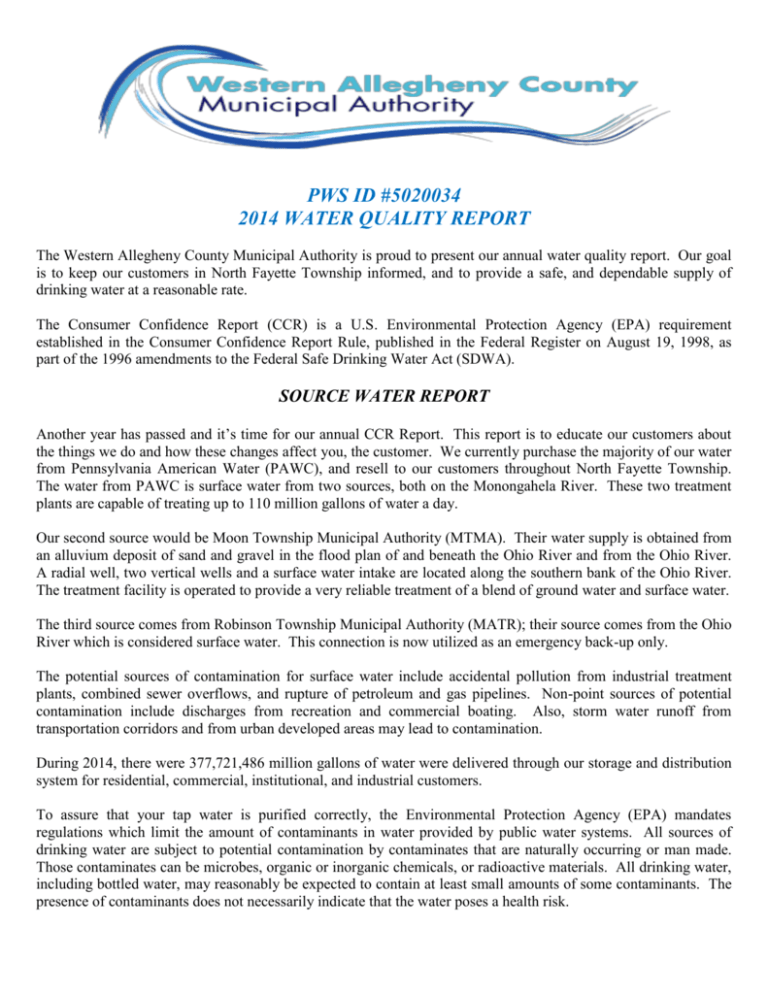
PWS ID #5020034 2014 WATER QUALITY REPORT The Western Allegheny County Municipal Authority is proud to present our annual water quality report. Our goal is to keep our customers in North Fayette Township informed, and to provide a safe, and dependable supply of drinking water at a reasonable rate. The Consumer Confidence Report (CCR) is a U.S. Environmental Protection Agency (EPA) requirement established in the Consumer Confidence Report Rule, published in the Federal Register on August 19, 1998, as part of the 1996 amendments to the Federal Safe Drinking Water Act (SDWA). SOURCE WATER REPORT Another year has passed and it’s time for our annual CCR Report. This report is to educate our customers about the things we do and how these changes affect you, the customer. We currently purchase the majority of our water from Pennsylvania American Water (PAWC), and resell to our customers throughout North Fayette Township. The water from PAWC is surface water from two sources, both on the Monongahela River. These two treatment plants are capable of treating up to 110 million gallons of water a day. Our second source would be Moon Township Municipal Authority (MTMA). Their water supply is obtained from an alluvium deposit of sand and gravel in the flood plan of and beneath the Ohio River and from the Ohio River. A radial well, two vertical wells and a surface water intake are located along the southern bank of the Ohio River. The treatment facility is operated to provide a very reliable treatment of a blend of ground water and surface water. The third source comes from Robinson Township Municipal Authority (MATR); their source comes from the Ohio River which is considered surface water. This connection is now utilized as an emergency back-up only. The potential sources of contamination for surface water include accidental pollution from industrial treatment plants, combined sewer overflows, and rupture of petroleum and gas pipelines. Non-point sources of potential contamination include discharges from recreation and commercial boating. Also, storm water runoff from transportation corridors and from urban developed areas may lead to contamination. During 2014, there were 377,721,486 million gallons of water were delivered through our storage and distribution system for residential, commercial, institutional, and industrial customers. To assure that your tap water is purified correctly, the Environmental Protection Agency (EPA) mandates regulations which limit the amount of contaminants in water provided by public water systems. All sources of drinking water are subject to potential contamination by contaminates that are naturally occurring or man made. Those contaminates can be microbes, organic or inorganic chemicals, or radioactive materials. All drinking water, including bottled water, may reasonably be expected to contain at least small amounts of some contaminants. The presence of contaminants does not necessarily indicate that the water poses a health risk. However, some people may be more vulnerable to contaminants in drinking water than the general population. Immune-compromised persons, such as persons with cancer undergoing chemotherapy, persons who have undergone organ transplants, people with HIV/AIDS or other immune system disorders, some elderly, and infants can be particularly at risk from infections. These people should seek advice about drinking water from their health care providers. EPA/CDC guidelines on appropriate means to lessen the risk of infection by cryptosporidium and other microbiological contaminants are available from the Safe Drinking Water Hotline (800-426-4791). This year we are continuing our infrastructure renewal process. As you may know we have been proactive in the renewal of our aging water lines and valves. As we continue to replace water lines throughout the township it continues to provide a more reliable water system to serve the residents. The replacement has been a great benefit as we are seeing less water main breaks and a lower loss of water that helps keep our rates lower than other water suppliers. Please keep in mind that all of our service trucks have our name on them and all service men have ID. If you are ever in question as to the identity of a worker, please feel free to call the office to confirm. As a neighborhood water Authority we strive to take care of your needs. Our service calls are responded to by local technicians who are familiar with the area. The office staff that answers the phone is located locally at 403 Virginia Drive, Oakdale, PA, Monday through Friday from 8:00 a.m. to 4:30 p.m. If you haven’t supplied us with an emergency number for our Reverse 911 Call System yet, please do so. If you would like, it can be done on our new website at www.wacmawater.com or call us at 412-788-4337. In an emergency this system will call each customer with important information about what you should do, without an emergency number you will not receive this information. We now accept online and credit card payments. A convenience fee will be charged by the credit card company but the authority does not retain any part of this fee. In case of any water emergency please check out the website for more information. www.wacmawater.com Information about Lead If present, elevated levels of lead can cause serious health problems, especially for pregnant women and young children. Lead in drinking water is primarily from materials and components associated with service lines and home plumbing. The Western Allegheny County Municipal Authority is responsible for providing high quality drinking water, but cannot control the variety of materials used in plumbing components. When your water has been sitting for several hours, you can minimize the potential for lead exposure by flushing your tap for 30 seconds to 2 minutes before using water for drinking or cooking. If you are concerned about lead in your water, you may wish to have your water tested. Information on lead in drinking water, testing methods, and steps you can take to minimize exposure is available from the Safe Drinking Water Hotline or at http://www.epa.gov/safewater/lead. Rate Information: Effective June 1, 2015 we will be increasing our water rate by $.14 per thousand gallons. This will increase our minimum by $.84, so our new minimum which includes 3000 gallons of water will be $49.17, and each additional 1000 gallons will be $5.95. This increase will only cost the average household $1.68 per quarter. Other Information: About Nitrate: Nitrate in drinking water at levels above 10 ppm is a health risk for infants of less than six months of age. High nitrate levels in drinking water can cause blue baby syndrome. Nitrate levels may rise quickly for short periods of time because of rainfall or agricultural activity. If you are caring for an infant, you should ask for advice from your health care provider. Thank you for allowing us to continue providing your family with clean, quality water this year. In order to maintain a safe and dependable water supply we sometimes need to make improvements reflected as rate structure adjustments. Thank you for understanding. We at the Western Allegheny County Municipal Authority work around the clock to provide top quality water to every tap. We ask that all our customers help us protect our water sources, which are the heart of our community, our way of life and our children’s future. Cryptosporidium is a microbial pathogen found in surface water throughout the U.S. Although filtration removes Cryptosporidium, the most commonly-used filtration methods cannot guarantee 100 percent removal. If the organism was detected, current test methods do not allow us to determine if the organisms are dead or if they are capable of causing disease. Ingestion of Cryptosporidium may cause cryptosporidiosis, an abdominal infection. Symptoms if infection includes nausea, diarrhea and abdominal cramps. Most healthy individuals can overcome the disease within a few weeks. Based on the results of our Cryptosporidium monitoring no additional treatment will be required by the new EPA regulation. Listed below is a table of leak statistics. Over time even a small leak will begin to add up as you can see below: Leak Stats: GALLONS PER MINUTE HOUR DAY MONTH 0.25 15 360 10,800 0.50 30 720 21,600 0.75 45 1,080 32,400 1.00 60 1,440 43,200 5.00 300 7,200 216,000 10.00 600 14,400 432,000 FREQUENTLY ASKED QUESTIONS Is there fluoride in the water? 1 ppm is added to assist in the prevention of dental cavities. How much sodium is in the water? The sodium level is approximately 39 ppm. Why the chemical smell? This is due to adjusted levels of chlorine depending upon the weather and river conditions. Why does the water look milky? This is due to air in the lines, which is normal after a water main break, and will clear within 24 hours. How hard is the water? Hardness levels range from 65 ppm to 174 ppm, or 4 to 10 grains per gallon of water. The table shows contaminants that were detected by the Western Allegheny County Municipal Authority, as well as our suppliers. In this table, you will see certain terms and abbreviations that you may not be familiar with. To better assist you with understanding these terms, we have provided the following definitions: Action Level (AL) – The concentration of a contaminant which if exceeded, triggers treatment or other requirements which a water system must follow. Maximum Containment Level (MCL) – The highest level of a contaminant permitted in drinking water. Maximum Containment Level Goal (MCLG) – The level of a contaminant in drinking water below which there is no known or expected health risk. Maximum Residual Disinfectant Level (MRDL) - The highest level of a disinfectant allowed in drinking water. There is convincing evidence that addition of a disinfectant is necessary for control of microbial contaminants. Maximum Residual Disinfectant Level Goal (MRDLG) – The level of a drinking water disinfectant below which there is no known or expected risk to health. MRDLG’s do not reflect the benefits of the use of disinfectants to control microbial contamination Millirems Per Year (mrem/yr) – A measure of radiation absorbed by the body Non-Detectable (ND) – Laboratory analysis indicates that the contaminant is not present at a detectable limit. Part Per Billion (PPB) – One part substance per billion parts water. Equivalent to micrograms per liter Parts Per Million (PPM) – One part substance per million parts water. Equivalent to milligrams per liter Picocuries Per Liter (pCi/L) – A measurement of radioactivity in water Treatment Technique (TT) – A process which is required to reduce the level of contaminants in drinking water Turbidity – A measurement of the clarity of water is a good indicator of the effectiveness of the filtration system. Turbidity is measured in nephelometric turbidity units (NTU). Not Applicable (N/A) – Does not apply. Clarity (Unit) Turbidity (NTU) MCL MCLG Source TT=95% of all monthly samples taken must be .3 NTU or less N/A PAWC/ Aldrich Sta. PAWC/ Hay’s Mine MTMA Substance (units) Trihalomethanes (ppb) Haloacetic Acids (ppb) Year Sampled 2013 MCL MCLG 80 2013 2013 Chlorine Residual (ppm) Detected Level 0.13(a) 0.18(a) .09(a) Violation? Yes/No No Source Soil Erosion N/A WACMA Level 48.2 Range of Detection 30-72 Violation? Yes/No No By-product of chlorination 60 N/A 10.7 0-22.8 No By-product of chlorination MRDL-4 MRDLG-6 .62 .30-.94 No Added as a disinfectant to the treatment process Radioactive Contaminants Beta Photon Emitters (pCi/L) Alpha Emitters (pCi/L) MCL MCLG 50 (b) 0 PAWC Detected Level 4 15 0 15 Radium – 228 (pCi/L) 20 0 1.4 (2003 data) Inorganic Contaminants (Unit) Barium (ppm) MCL MCLG 2 Nitrate (ppm) Violation? Yes/No No Likely Source of Contamination No Erosion of natural deposits ND (2003 data) No Erosion of natural deposits PAWC Detected Level MTMA Detected Level Violation? Yes/No Likely Source of Contamination 2 0.032 N/D (c) No 10 10 .90 No Fluoride (ppm) 2 2 0.95 (d) 0.62 (b) 0.74 (b) Selenium (ppb) 50 50 0.05 N/D No Arsenic (ppb) 50 0 0.01 N/D No Additional Inorganic Contaminants: Lead (ppb) MCL MCLG AL=.15 0 Copper (ppm) AL=1.3 1.3 MTMA Detected Level ND (2002 data) (c) .2 (2003 data) Source 90th Percentile 0 (2013 data) .203 (2013 data) No Samples above AL 0 Violation? Yes/No No 0 No Decay of natural and manmade deposits Discharge from drilling wastes and metal refineries; Erosion of natural deposits Runoff from fertilizer use; Erosion of natural deposits Added to your water to promote healthy teeth Discharge from petroleum, and metal refineries, and mines; Erosion of natural deposits Erosion of natural deposits; runoff from orchards; runoff from glass and electronics production wastes Likely Source of Contamination Corrosion of household plumbing systems Corrosion of household plumbing systems Note: (a) All daily turbidity samples from all suppliers met the required turbidity level of .3 NTU or less. (b) The MCL for Beta particles is 4 mrem per year. The EPA considers 50 pCi/L the level of concern for Beta particles. (c) Only one sample taken. (d) PAWC states that this was a short term event which affected a small portion of their system. The table below details the unregulated contaminants that were detected in the water. Substance units Year sampled Average MCL/ MCLG Bromochloromethane 2014 327 Not regulated Range Low – High 220-350 Chlorate 2014 144 Not Regulated 83-360 Chromium 2014 .64 Not Regulated .25-1.1 Cobalt 2014 1.1 Not Regulated 1.1 Hexavalent Chromium 2014 0.28 Not Regulated 0.098-0.65 Molybdenum 2014 1.1 Not Regulated 1.-1.3 Vanadium 2014 .37 Not Regulated 0.22-0.66 Typical Source Used as a fire-extinguishing fluid, an explosive suppressant, and as a solvent in the manufacturing of pesticides Agricultural defoliant or desciccant; disinfection byproduct; and used in production of chlorine dioxide Naturally-occurring element; used in making steel and other alloys; chromium 3 or 6 forms are used for chrome plating, dyes and pigments, leather tanning and wood preservation Naturally-occurring element found in the earth’s crust and at low concentrations in sweater, and in some surface and ground water, cobaltous chloride was formerly used in medicines and as a germicide Naturally-occurring element; used in making steel and other alloys; chromium 3 or 6 forms are used for chrome plating, dyes and pigments, leather tanning and wood preservation Naturally-occurring element found in ores and present in plants, animals and bacteria; commonly used form of molybdenum trioxide used as a chemical reagent Naturally-occurring elemental metal; used as vanadium pentoxide which is a chemical intermediate and a catalyst Notice of Unregulated Contaminants: The Western Allegheny County Municipal Authority has sampled a series of unregulated contaminants. Unregulated contaminants are those for which EPA has not established drinking water standards. The purpose of unregulated contaminant monitoring is to assist EPA in determining the occurrence of unregulated contaminants in drinking water and whether future regulation is warranted. As our customers you have the right to know the results of sampling. IF you are interested in examining the results, please contact the WACMA office at 412-7884337, or visit our office at 403 Virginia Drive, Oakdale, PA 15071. WATER SYSTEM INFORMATION The Western Allegheny County Municipal Authority office is located at 403 Virginia Drive, Oakdale, PA 15071. If you have any questions about this report or concerning your water utility, please contact the Authority Office at 412-788-4337. We want our valued customers to be informed about their water supplier. If you want to learn more, please attend any of our regularly scheduled meetings. They are held on the Third Tuesday of each month at 7:30 P.M. at the Authority Office. Additional information available at the following websites: Western Allegheny County Municipal Authority, www.wacmawater.com Pennsylvania Department of Environmental Protection, www.dep.state.pa.us/ United States Environmental Protection Agency, www.epa.gov/safewater.com Centers for Disease Control and Protection, www.cdc.gov Safe drinking water hotline: (800) 426-4791 This report was intended to communicate important information about your drinking water and the companies that supply it. If you do not understand it, please have someone translate it for you. Este informe contiene information muy importante sobre su agua de beber. Traduzcalo o hable con alguien que lo enienda bein.
